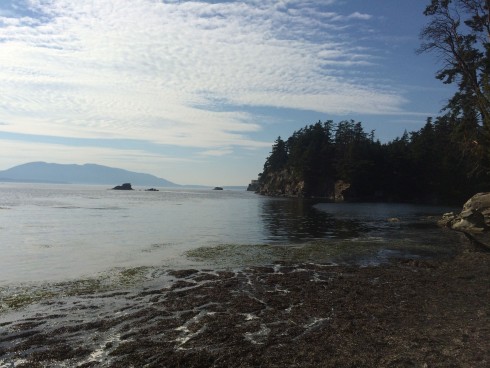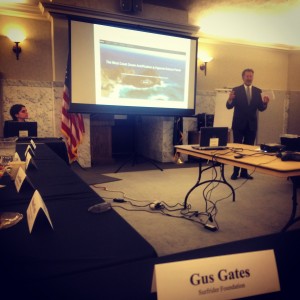
Washington is a leader in addressing ocean acidification. While the challenges that we face are large, we have much to draw on to tackle this problem and it starts with an active an informed citizenry. While it’s important to recognize that this is a global issue largely resulting from the increased amount of carbon dioxide (CO2) being pumped into the atmosphere and absorbed by the ocean, it’s also important to understand that there are local actions that can help mitigate the impacts of acidification on aquatic ecosystems and regional economies and cultures. This post is aimed to serve as a synthesis of the wealth of information that is out there on this issue, look for regular updates on this blog & topic moving forward.
What is ocean acidification (OA)?
Over recent years, human activities such as the burning of fossil fuels (coal, oil, natural gas) have increased the amount of carbon dioxide gas emitted to the atmosphere—and the amount that dissolves into the ocean. Now, so much carbon dioxide has been absorbed by the ocean that the chemistry of seawater is changing, causing the ocean to become more acidic. Read more in our Beachapedia post on ocean acidification. Many life processes are sensitive to carbon dioxide and pH. Research shows calcifiers are particularly affected by ocean acidification. Calcifiers are marine organisms that depend on the mineral calcium carbonate to make shells, skeletons, and other hard body parts. Ocean acidification makes an essential component of calcium carbonate – the carbonate ion – more scarce. As a result, calcifiers have to use more energy to pull carbonate ions out of the water to build their shells. Calcium carbonate also dissolves more easily as acidity increases. These changes can result in slower growth and/or higher mortality among calcifiers, especially in shellfish larvae and juvenile shellfish.
Recent studies also document the presence of local coastal acidification hotspots where freshwater inputs, pollutants, and soil erosion are blamed for acidifying waters (lowering the pH) at higher rates than atmospheric CO2 alone. These non-atmospheric inputs can have large consequences when combined with upwelling events that bring low pH water to nearshore areas and additional sources such as sulfur dioxide precipitation, hypoxia, eutrophication, emissions and run-off of acidic fertilizers. Here in the Pacific Northwest, we are particularly vulnerable to the effects of OA, read more in this PNW OA fact-sheet.
Why is this issue such a concern to Washingtonians?
Washington State has the most productive commercial shellfish industry on the West Coast. Annual sales of farmed shellfish from Washington account for almost 85 percent of U.S. West Coast sales, including Alaska. The shellfish industry generates $270 million annually, and directly and indirectly supports 3,200 jobs, which is a significant contributor to our coastal and state economy, as well as part of our culture and a significant contributor to the quality of life that we enjoy here in the PNW.
Additionally, more than 30 percent of Puget Sound’s marine species are calcifiers: oysters, clams, scallops, mussels, abalone, crabs, geoducks, barnacles, sea urchins, sand dollars, sea stars and sea cucumbers. Even some seaweeds produce calcium carbonate structures. Many calcifiers provide habitat, shelter, and/or food for various plants and animals. For example pteropods (pronounced “TARE-a-pods”), the delicate free-swimming snails, are eaten by seabirds, whales and Alaska pink salmon. Some species of copepods - small crustaceans eaten by juvenile herring and salmon – are also affected. Impacts on species like the pteropods and copepods are a significant concern because of their ability to affect the entire marine food web.
Because of these impacts that we face in Washington and to our marine ecosystem, Governor Gregoire convened the Blue Ribbon Panel on Ocean Acidification in February, 2012, making Washington the first state in the nation to tackle ocean acidification at this level. The 28 member Panel consisted of scientists; public opinion leaders; industry representatives; state, local, federal, and tribal policy makers; and conservation community representatives. The Panel was charged by the Governor with reviewing the best available science, and producing a set of recommendations to guide Washington’s response to ocean acidification. Download the full report, Washington State Blue Ribbon Panel on Ocean Acidification: From Knowledge to Action.
Continuing to be Leaders & Addressing the Challenge
Not wanting the Blue Ribbon report to sit on the shelf and collect dust, the 2013 Legislature enacted Senate Bill 5603 Section 4 creating the Washington Marine Resources Advisory Council, within the Office of the Governor. The Marine Resources Advisory Council’s membership includes legislative, executive, and elected officials, nongovernmental organizations, and private sector. Representatives from academic institutions and federal agencies have been invited by the Governor to participate.
The Marine Resources Advisory Council (MRAC) has the following powers and duties:
- To maintain a sustainable coordinated focus on ocean acidification;
- To advise and work with the Washington Ocean Acidification Center on the effects and sources of ocean acidification; (Check out the NANOOS Site for a wealth of information related to OA)
- To deliver recommendations to the Governor and Legislature on ocean acidification;
- To seek public and private funding resources to support the Advisory Council’s recommendations; and
- To assist in conducting public education activities regarding ocean acidification.
Surfrider Foundation has representation on MRAC through the non-fishing recreation seat, having recently filled by WA Policy Manager Gus Gates after being appointed by Governor Inslee in December. If you are interested in learning more, or attending a future meeting, contact Gus.
 WA State Senator & MRAC member Kevin Ranker addresses the Advisory Council at a recent meeting in Olympia
WA State Senator & MRAC member Kevin Ranker addresses the Advisory Council at a recent meeting in Olympia
Think Global, Act Regional, Implement Local Solutions
Ocean acidification and hypoxia, two phenomena often coupled due to biological and oceanographic processes, are leading to concerns among government agencies and the public along the West Coast about the potential threats to marine ecosystems. These issues are shared challenges among the region and require cooperation across academic and political landscapes.
At the nexus of this challenge is the West Coast Ocean Acidification and Hypoxia Science Panel, an interdisciplinary collaboration of 20 esteemed scientists representing California, Oregon, Washington, and British Columbia. The Panel’s core goal is to collaborate with decision makers across the state, regional and federal levels on these complex issues. The Panel established a series of working groups to summarize knowledge for action on key themes identified by decision makers. Learn more about the West Coast OAH Panel & sign up for their newsletters to stay up to date on current info!
Phytoremediation in the Hood Canal- The Puget Sound Restoration Fund recently received a $1.5 million grant from the Paul Allen Family Foundation to conduct research on growing kelp as way to sequester carbon dioxide from the water. Researchers are planning to grow 3 acres of sugar kelp north of the Hood Canal Bridge in an effort to save shellfish, and thereby larger ocean life and they are working in partnership with NOAA and the Washington State Department of Natural Resources. Check out the cool video on their work.
If you've made it this far, congratulations...their is a ton of information on this issue and this is only skimming the tip of the iceberg. Stay tuned for more updates in the future, including additional information on local actions and solutions that can be taken to help address this challenge.


